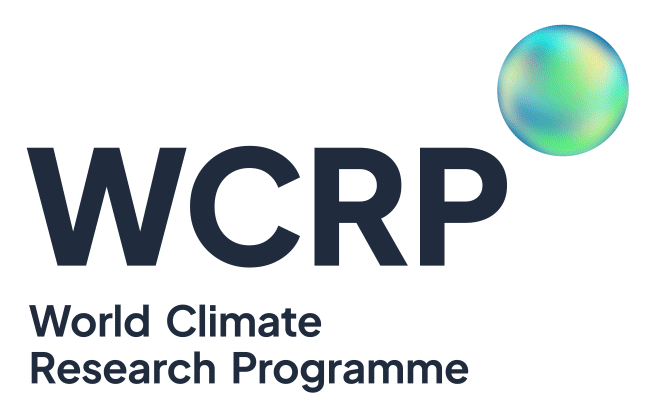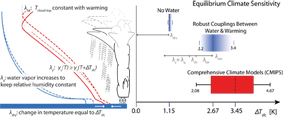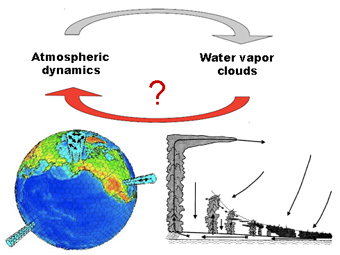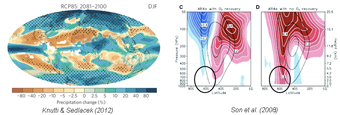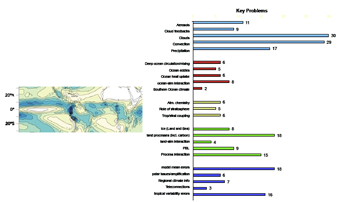Led by Steven Sherwood (CCRC, Australia) & Mark Webb (MetOffice, UK)
Aim: Design critical tests for climate models, whose application will help assess the most likely estimates of climate and hydrological sensitivity.
Focus: Intensify efforts to identify causes of inter-model differences in sensitivity; Interpret robust features; Explain extreme behaviours; Unravel uncertainties and propose strategies to tackle them.
Led by Pier Siebesma (KNMI, Netherlands) & Dargan Frierson (Washington Univ., USA)
Aim: Tackle the parameterization problem through a better understanding the interaction between cloud / convective processes and circulation systems.
Focus: Lessons from observations and cloud-resolving modelling over large domains; Interaction between diabatic heating and large-scale dynamics.
Led by Ted Shepherd (Univ. Reading, UK) & Adam Sobel (Columbia Univ., USA)
Aim: Better anticipate how large-scale atmospheric circulation will respond to anthropogenic forcings (GHG, aerosols, ozone).
Focus: Role of local vs large-scale or remotely forced changes in driving regional changes; Identify robust responses; Interpret uncertain components; Assess the impact of model biases or shortcomings on regional responses
Related activities:
Led by Masa Kageyama (IPSL, France) & Robert Pincus (CIRES, USA)
Aim: Exploitation of observations of the recent past, or proxies for longer-term changes, to better constrain cloud processes and feedbacks.
Focus: Analysis of decadal/multi-decadal records from satellite and in-situ observations; Improvement of paleo-climates reconstructions and syntheses; Comparisons of past vs future changes.
Led by Christian Jakob (Monash Univ., Australia) & Masahiro Watanabe (Tokyo Univ., Japan)
Aim: Interpret and reduce model errors to gain confidence in projections and predictions.
Focus: Long-standing model biases (at least a few of them); Understand how model errors or shortcomings impact projections and predictions; Gain physical understanding of the climate system through model development.
The easy aerosol model-intercomparison project is an activity of the initiative on changing patterns
Recent climate modelling studies illustrate the potential of aerosols to change large-scale atmospheric circulation, and with this the global patterns of precipitation. However, it remains unclear to what extent the proposed aerosol-induced changes reflect robust model behavior or are affected by uncertainties in the models of physical processes, most notably those related to moist phenomena. Easy Aerosol addresses these questions by subjecting comprehensive atmosphere general circulation models to the same set of idealized easy aerosol perturbations that are designed based on a global aerosol climatology and mimic the gravest mode of the anthropogenic aerosol.
Easy Aerosol is part of the WCRP Grand Challenge on "Clouds, circulation, and climate sensitivity" and the COOKIES&CREAM project of EUCLIPSE. The document below discusses the motivation of Easy Aerosol, describes the aerosol perturbations, and defines the experimental protocol. The input files required to run the simulations are provided below:
- The monthly climatologies of the Delta SST patterns required for the Easy Aerosol simulations
- dsst_3plumesaerosol.nc (868k - 2 Jan. 2014, v.7)
- dsst_zonalaerosol.nc (868K - 2 Jan. 2014, v.7) - The land-sea mask of ECHAM6 on T63 grid
- echam6_slm_t63.nc (75k - 2 Jan. 2014, v.7) - For reference the following Fortran90 module contains the implementation of the aerosol perturbations in ECHAM6
- mo_aero_easyaerosols.f90 (19.5 KB - Jan. 2014)
If you are interested in participating or have any questions please contact Aiko Voigt (
Related documents:
- A. Voigt, B. Stevens, S. Bony, O. Boucher : Easy Aerosol - a modeling framework to study robustness and sources of uncertainties in aerosol-induced changes of the large-scale atmospheric circulation (November 2013)
